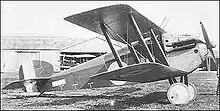Gordon Budd Irving
Captain Gordon Budd Irving was a Canadian World War I flying ace credited with twelve aerial victories.[1][2]
Gordon Budd Irving | |
|---|---|
| Born | 16 May 1898 Toronto, Canada |
| Died | 11 August 1918 (aged 20) Vicinity of Albert, France |
| (1) Arras Flying Services Memorial (2) Mount Pleasant Cemetery | (1) Pas de Calais, France (2) Toronto, Canada |
| Allegiance | George V of the British Empire |
| Service/ | Aviation |
| Years of service | 1917–1918 |
| Rank | Captain |
| Unit | No. 19 Squadron RAF |
| Awards | Distinguished Flying Cross |
Early life
Gordon Budd Irving was the sole son of attorney William Henry Irving and Mary Maude Smith[3] Irving.[4] His childhood home was at 76 Spadina Street, Toronto; he attended church nearby at Trinity Methodist Church (present-day Trinity-Saint Paul's United). After education at the Huron Street Public School and University of Toronto Schools, he was briefly employed by National Trust Company.[5][6][7]
World War I service
Irving then joined the Royal Flying Corps in May, 1917[5][6] and sent to Camp Borden for training. He shipped out for England in July 1917.[7] By November of that year, he had been trained and posted to No. 19 Squadron RFC. He was assigned a Sopwith Dolphin to fly.[8]

Irving scored his first aerial victory on 24 March 1918; by 2 July, his count was up to three enemy planes destroyed and eight driven down out of control. During five of these victories, he had teamed with other aces, including Cecil Gardner, Finlay McQuistan, John Aldridge, James Hardman, and fellow Canadian Albert Desbrisay Carter. Irving had also risen to the position of Flight Commander[5] in May.[2]
Decoration and death
On 3 August, he was awarded the Distinguished Flying Cross.[9] Eight days later, in a dogfight during a patrol, he drove down a Pfalz D.III fighter for his ninth out of control victory.[8] Irving was reported as missing in action, as three Dolphins went down that day, one of them on fire. Irving's body was not recovered.[10]
His Officer Commanding, Major D. J. Pretyman, wrote "...he is a great loss to my squadron as he was loved by all the officers and men, besides being a very gallant gentleman and always ready to do his best." The Prince of Wales posthumously awarded the DFC to Irving's sister, Mrs. Kathleen Purves.[3][11] The most likely claimants for victory over Irving were either Justus Grassmann or Alois Heldmann.[8]
Honours and awards
Distinguished Flying Cross (DFC)
Lt. (T./Capt.) Gordon Irving.
He has carried out numerous offensive patrols, and under his able leadership many enemy formations have been successfully engaged. He has personally accounted for six enemy aircraft, and by his consistent keenness and fearlessness he sets a fine example to the pilots in his squadron.[9]
Sources of information
- The Aerodrome website Retrieved on 7 March 2010.
- Shores et al (1990), p. 208
- (Inscription on tombstone at Mount Pleasant Cemetery, Toronto, Canada) "Gordon Budd Irving". Archived from the original on 15 November 2009. Retrieved 8 March 2010.
- Retrieved on 7 March 2010.
- Retrieved on 7 March 2010.
- "Retrieved on 7 March 2010". Archived from the original on 6 July 2011. Retrieved 8 March 2010.
- "Gordon Budd Irving". Archived from the original on 15 November 2009. Retrieved 8 March 2010.
- Franks, p. 24.
- (Supplement to the London Gazette, 3 August 1918) http://www.london-gazette.co.uk/issues/30827/supplements/9200 Retrieved on 7 March 2010.
- (Toronto Star, 3 September 1918) "Gordon Budd Irving". Archived from the original on 15 November 2009. Retrieved 8 March 2010. Retrieved on 7 March 2010.
- (Trinity War Book, Trinity Methodist Church, Toronto, Canada) "Gordon Budd Irving". Archived from the original on 15 November 2009. Retrieved 8 March 2010. Retrieved on 7 March 2010.
References
- Franks, Norman. Dolphin and Snipe Aces of World War 1. Osprey Publishing, 2002. ISBN 978-1-84176-317-0, ISBN 978-1-84176-317-0.
- Shores, Christopher F. et al. Above the Trenches: A Complete Record of the Fighter Aces and Units of the British Empire Air Forces 1915-1920. Grub Street, 1990. ISBN 978-0-948817-19-9, ISBN 978-0-948817-19-9.